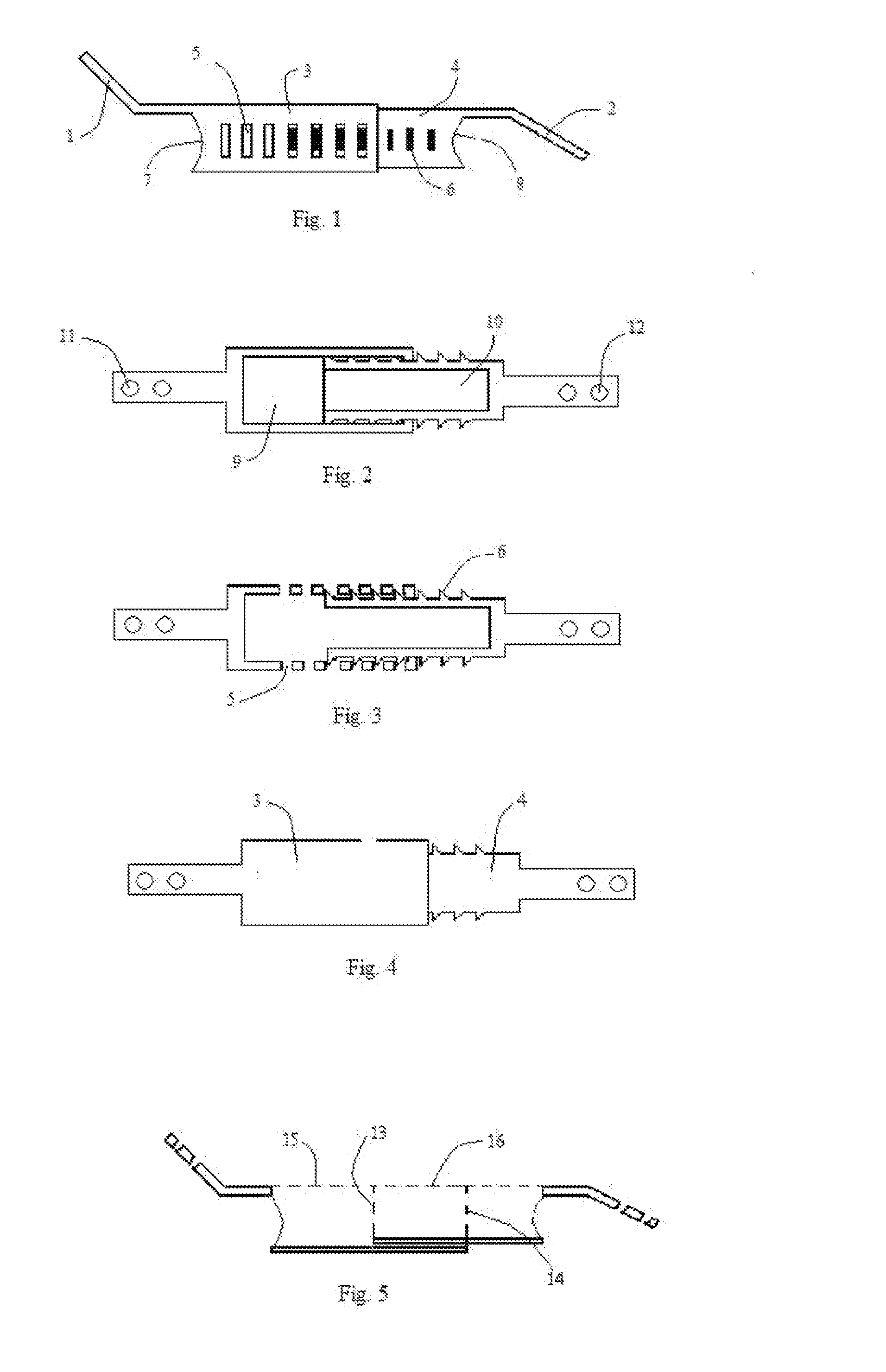[0006]The present invention relates a laminar fusion and fixation
system following either open door or double door
laminoplasty technique. This
system with the spacer and plate reduces surgical time and simplifies laminar fixation and fusion if needed after
laminoplasty.
[0011]The telescopic spacer allows the extent of the laminar displacement to be adjustable by increasing or decreasing the spacer length after lamina fixation device has been implanted. Henceforth, it avoids the need for different size implants as one
implant can be adjusted to fit all variations in
spinal anatomy as well as the extent of the
spinal canal decompression desired. The spacer telescopic components can also contain an engaging mechanism to
interlock with each other through
ratchet teeth to maintain the adjusted length. Alternative spacer telescopic engaging mechanisms can include screws, ridges, hooks, recesses, or a ball and socket mechanism.
[0015]A minimally invasive approach is undertaken with small incisions and serial dilation of the
soft tissue along with splitting of the paraspinal muscles from the
skin to the spine. A tubular port or any other shape
retractor is then placed to maintain the
exposure. The drilling of the lamina and if needed the
spinous process is undertaken with this
exposure using either an
endoscope or
microscope magnification and subsequently the lamina are displaced to widen the
spinal canal. A laminoplasty
implant is then placed and secured to the lamina and
facet. Due to the small
exposure, a laminoplasty implant that can contract to allow placement in the spine and then expand to the position desired after implant is ideal for this approach. The telescopic spacers described herein are ideal for this approach. The tubular port is then removed and the
skin incision closed. Intra-operative x-rays or a
navigation system can be used to localize the spine level and confirm correct
implant placement.Another variation of the open door laminoplasty is the
expansive laminoplasty most suited for the
thoracolumbar spine. In this method, the lamina on either side at the junction of the facets are drilled and opened. A lateral
spinal canal recess decompression and / or foraminotomy is undertaken and the lamina replaced with the spacer construct on both sides between the displaced lamina and facets. The present invention relates a laminar fusion and fixation
system following laminoplasty. This system with the telescopic spring spacer reduces surgical time and simplifies laminar fixation after laminoplasty.
[0017]In another embodiment of the bone spacer, the edges have a superior
cuff or shoulder that allows securement against the lamina and facet on both sides as well prevent migration of the spacer into the spinal canal. The spacer can also be resorbable and made of hydroxyapatite or similar absorbable material which is eventually resorbed and / or replaced with
autologous bone during the fusion process.
[0019]In another embodiment the
allograft bone or resorbable graft and plate are constructed as a unit with the bone graft / spacer attached to the plate in the middle through either screws or an
adhesive material.In another embodiment, the bone graft and plate are designed for laminar fusion and fixation following double door laminoplasty. The bone graft or spacer in the middle allows for laminar fusion in the decompressed position with the plate design bent on either end securing the spacer to the lamina and facet.
[0024]The telescopic component of the fixation system allows the two portions of the plate to slide into or away from each other thereby adjusting the spacer length and provides for laminar displacement after the device has been implanted. This avoids the need for manually displacing the lamina during
surgery at which time with the traditional procedure, several spacer implant sizes are tested to find the right size that conforms to the patient's spine
anatomy.
 Login to View More
Login to View More  Login to View More
Login to View More 


